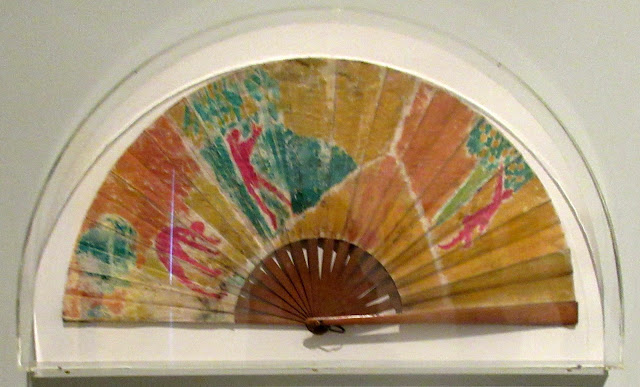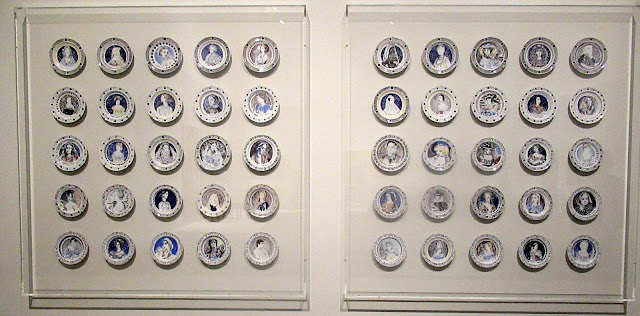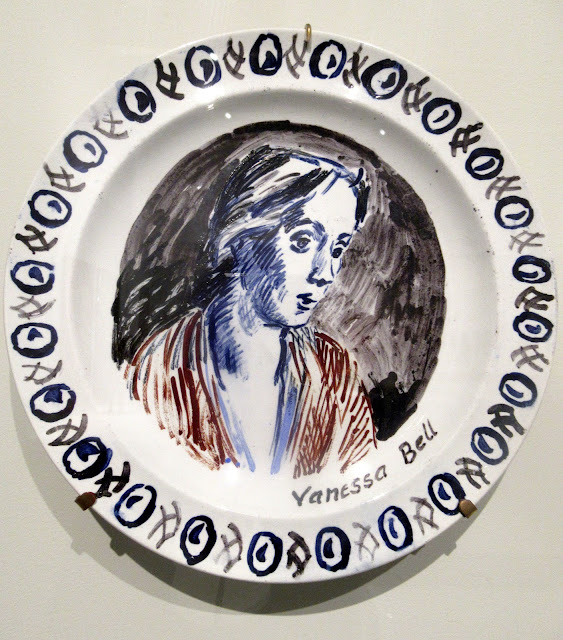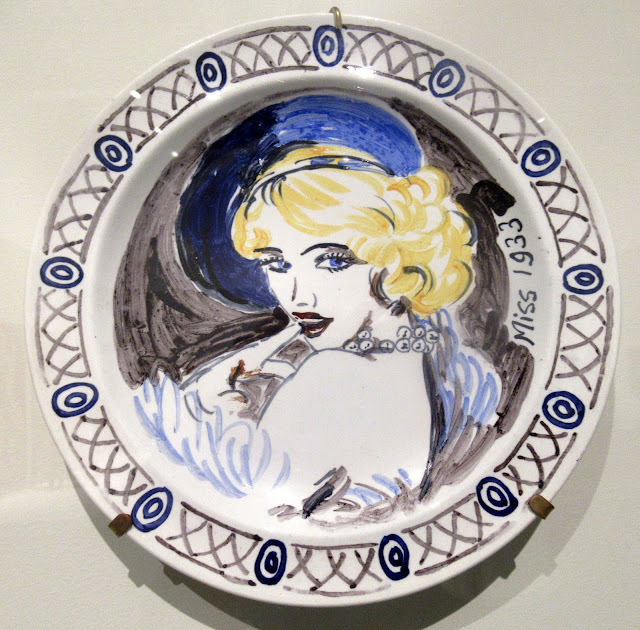Vanessa Bell - A World of Form and Colour: Furniture, Textiles, Ceramics.
I am going to reproduce the introdution from the first post so that each post can stand independently, but if you have seen it, then skip the introdution and go straight to the photographs.
We went to to Milton Keynes (you can see my post on the town here ) especially to see this exhibition. It's the largest ever display of work by Bell and it was fantastic. There were some paintings that I was hoping to see which were not part of the exhibition, particularly Strudland Beach, but it did not matter, as there was so much wonderful work there to see. There is a post on Strudland Beach which you can see here . You can also see all three versions of that iconic painting here .
Bell was a pioneering modernist. Her work was at the forefront of British abstraction, but she also produced many portraits, still lifes and landscape paintings. At the same time, she created conditions in which artists could flourish. This involved organising the Friday Club for artists to meet and co-founding the experimental design collective, Omega Workshops.
She was also an important part of the Bloomsbury Group, a circle of influential English artists, writers and intellectuals in the first half of the 20th century. Collaboration formed an essential part of Bell's approach to art, including with her sister, Virginia Woolf, and the artist Duncan Grant with whom Vanessa Bell's all-encompassing approach to art found its ultimate expression in Charleston, the farmhouse they shared in East Sussex.Vanessa Bell was born into a wealthy literary family living in Kensington, London. She studied art in South Kensington and at the Royal Academy Schools. Following the death of her parents, Bell moved, together with her siblings, to 46 Gordon Square in the unfashionable Bloomsbury area where she rejected Victorian attitudes and sought a radical new way of living. She began the Friday Club where male and female artists were regarded as equals and exhibited together.
In 1913, Vanessa Bell, Roger Fry and Duncan Grant co-founded the Omega Workshops. Here, they rejected Victorian and Edwardian styles and challenged the barriers between fine and decorative art by designing modern furniture, textiles and ceramics.
Design for a folding screen: Adam and Eve, 1913-14, (graphite, bodycolour + oil on woven paper)
Art historian Christopher Reed has discussed Bell's representation of Adam and Eve as an 'ambition to have Eden without the Expulsion... These energetic nudes dance their way through a narrative that promises to end, but in the enveloping warmth of the yellow light they reach into'.
Nude with Poppies, 1916, (oil on canvas)
Bell paintd Nude with Poppies as a preliminary design for a bedhead commissioned by her friend, and Clive Bell's partner, Mary Hutchinson. She worried about its reception: 'I hope she won't be horrified to hear there's a nude figure of the most romantic description with poppies'.
Vanessa Bell and Roger Fry, Omega painted desk, 1912, (paint on wood)
The Omega Workshops, established by Roger Fry in 1913 with Duncan Grant and Vanessa Bell as co-directors, sold furniture, fabrics and household accessories designed and made by artists. Objects were shown anonymously and sold unsigned. In the run up to the launch of the Workshops Bell wrote to Roger Fry: 'I do think we shall have to be careful, especially in England where it seems one can never get away from this fatal prettimess. Can't we paint stuffs (fabrics) which won't be gay and pretty?'
looking closer
For this scheme Bell painted friezes, inlaid furniture, created mosaics and stained glass, and designed a special rug for the entrance hall. The final design is shown here, as well as a more densely packed preliminary design.

Tea Things, 1919, (oil on panel)
White
Pamela
Designed 1913, printed 2024, (linen, cotton and nylon)
Three textile patterns for the Omega that are attributed to Bell
From the 1920s onwards Bell also designed dust jackets for the books published by Hogarth Press, owned by Virginia and Leonard Woolf, including all of Virginia Woolf's all publications. From the days of the Omega Workshops, Bell had been producing and decorating ceramics and textiles and this continued after the Workshops' closure in 1919, working in collaboration with potters including her son Quentin and designers including Clarice Cliff. Bell and Grant's largest ceramic production was the Famous Women Dinner Service commissioned by art historian Kenneth Clarke in 1932, which included 50 decorated plates celebrating famous women throughout history.
Doors of Duncan Grant's bedroom at Charleston, 1918
In early 1917 Bell decorated the fireplace in Duncan Grant's bedroom and in 1918 painted the two doors.
Decorated Screen, 1920, (watercolour and gouache, with chalk, charcoal and graphite and with paper collage elements)
Decorated by Vanessa Bell Table, 1950, (painted wood)
Vanessa Bell, Vase and Flowers, 1929, (oil on canvas)
Vanessa Bell and Duncan Grant, Fire surround, 1929, (oil on wood)
Duncan Grant, Bacchanale, 1929, (oil on canvas)
Duncan Grant, The Toilet of Venus, 1928, (oil on canvas)
Vanessa Bell and Duncan Grant, Chairs, 1929, (wood and Cane)
Vanessa Bell and Duncan Grant, Famous Women Dinner Service, 1932-34, (50 hand-painted Wedgwood ceramic plates)
In 1932, the art historian Kenneth Clark and his wife Jane Clark ordered a fine dining dinner service from Bell and Grant. They received a service including 50 plates painted with portraits of famous women, as well as the artists themselves. The famous women they chose to depict came from across the world and from ancient history to the contemporary.
The Famous Women Dinner Service forms part of a wider ambition to record women's histories, with Virginia Woolf later writing: 'The history of England is the history of the male line, not the female. Of our father we know always some fact, some distinction. They were soldiers or they were sailors; they filled that office or made that law. But our mothers, our grandmothers, our great-grandmothers, what remains?'
Bell described the dinner service in typically modest and tongue-in-cheek fashion, as 'portraits of celebrated females - it ought to please the feminists - of all times'.
Vanessa Bell and Duncan Grant, Studies for the Muses of Arts and Sciences, 1920, (oil on canvas)
In 1920 John Maynard Keynes commissioned Bell and Grant to decorate his study with panels on either side of the door and bookcase, as well as curtains and furnishing. The artists planned eight figures - four male (by Grant) and four female (by Bell) - representing the muses of the arts and sciences, although, as Bell wrote 'in fact we're always changing theirs arts and their sciences'. Their recent experience of visiting Italy and of seeing Italian Renaissance fresco painting may have influenced these decorations.
From 1931 Bell and Grant began collaborating with the potter Phyllis Keyes. Keyes supplied many pots, jugs, tiles and vases for the artists to paint.





































Hi Eirene,
ReplyDeleteI wish there was a way of looking at Vanessa Bell without all the hype and drama of the Bloomsbury group and their snobbery, privileged existence and the endless prurient interest of the media and newspapers into their lives.
For me, I think Vanessa Bell would do well to be seen on her own terms.Decent painter, her real talent was breaking grounds and experimenting with "modernity".
I also went to an exhibition of hers at the Courtauld, and her contribution to the decorative arts was very interesting and with freshness and flair. We take those rugs, furniture and bits-and-bobs for granted now, but they must have been quite a shock.
Would be nice if I can visit this exhibition, but I've done about 3 or 4 this month alone and travelled abroad to see a speical one.
Thanks for the write up,
Liam :)
It's quite interesting Liam, I don't mind the hype around Bell at all. I think it's probably because so many women artists have been overlooked and ignored that I think it's quite refreshing. But, I do see what you mean.
DeleteI saw quite a bit of her work at the Courtauld a few years ago, and was so pleased about that.
We just can't see all the exhibitions we want to, unfortunately. I have to come to terms with the fact that there's one at the Tate that I will miss even though I have wanted to go and see it for months now. Oh well.